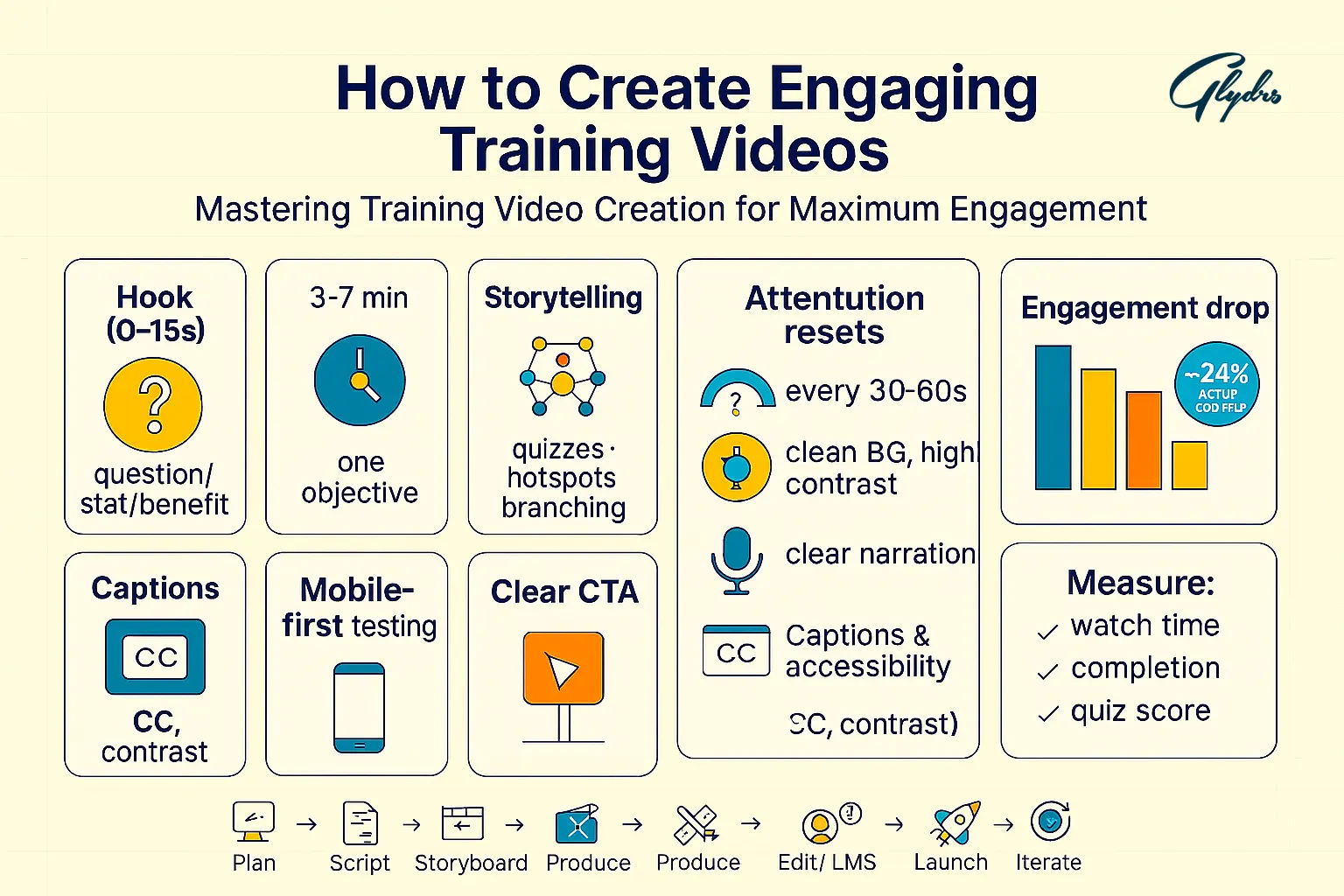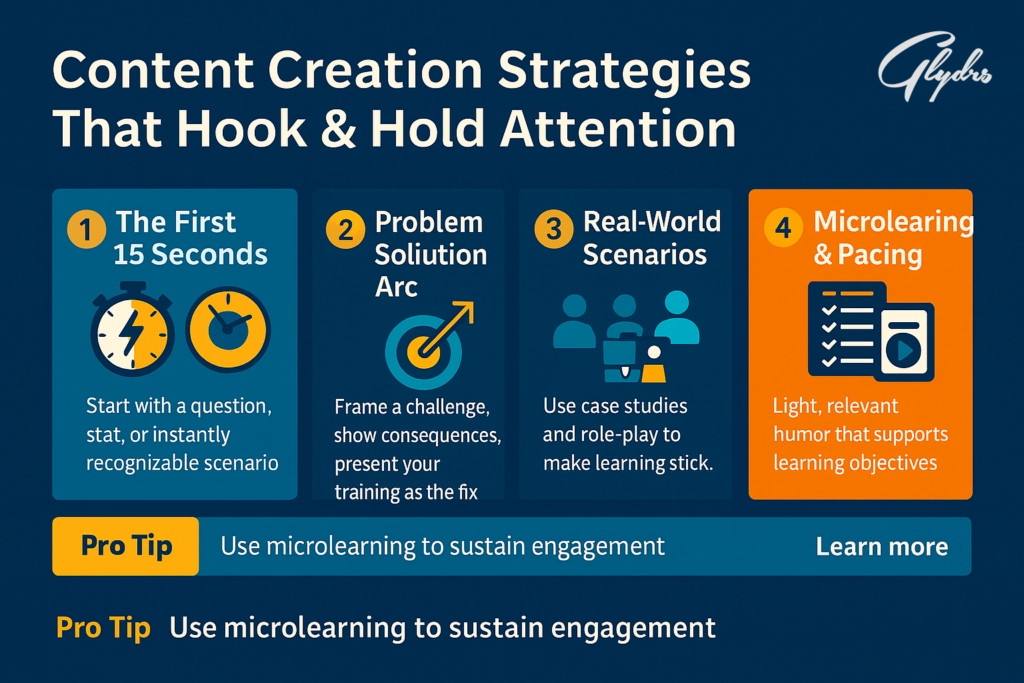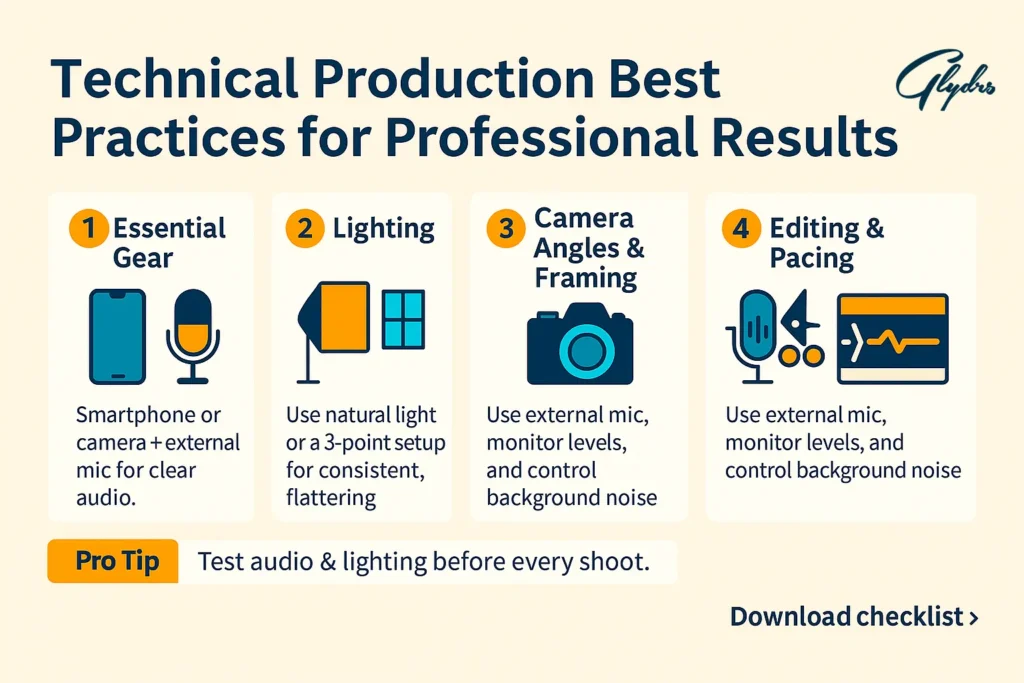
01 Oct How to create training video engaging content
Mastering Training Video Creation for Maximum Engagement
You’ve probably experienced it yourself – clicking play on a training video only to find your attention drifting within the first few minutes. The statistics are sobering: research shows that viewer engagement drops dramatically after just six minutes, with only 24% of viewers maintaining focus beyond the 20-minute mark. This isn’t just inconvenient; it’s costly.
When your carefully crafted training content fails to engage, you’re not just wasting production time and budget. You’re missing critical opportunities to develop your team’s skills, ensure compliance, and drive organizational growth. Traditional lecture-style videos, where an instructor drones on while learners passively watch, simply don’t work in today’s fast-paced digital environment, where attention spans are shorter and expectations for interactive, engaging content are higher.
The challenge isn’t that people don’t want to learn – it’s that most training video content is designed without considering the psychology of engagement. Your learners are bombarded with information daily, from social media to streaming platforms that have mastered the art of keeping viewers hooked. To compete for their attention, your training content needs to be just as compelling.
The Psychology Behind Engaging Training Content
Understanding how people learn and process information is crucial to creating training videos that stick. Your brain processes visual information 60,000 times faster than text, which means you have a natural advantage when using video – but only if you leverage it correctly.
Cognitive load theory tells us that learners can only process a limited amount of information at once. When you overload viewers with dense content, complex visuals, and lengthy explanations simultaneously, their brains essentially shut down. The key is managing this cognitive load by presenting information in digestible chunks, using clear visual hierarchies, and allowing processing time between concepts.
Different learning styles also play a crucial role in engagement. While the traditional model of visual, auditory, and kinesthetic learners has evolved, research shows that people do have preferences for how they receive and process information. Your most effective training videos will incorporate multiple modalities – combining spoken narration with visual demonstrations, interactive elements, and opportunities for reflection.
Emotional engagement triggers are perhaps the most powerful tool in your arsenal. When you create an emotional connection through storytelling, humor, or relatable scenarios, you activate the limbic system, which is directly connected to memory formation. This is why you remember movie plots years later but forget training content within days – one engages your emotions, the other typically doesn’t.
Pre-Production Planning: Laying the Foundation for Engagement
Before you hit record, you need to build a solid foundation that prioritizes engagement from the ground up. This starts with deeply understanding your audience beyond basic demographics. You need to know their pain points, their daily challenges, their preferred communication styles, and what motivates them to learn.
Create detailed learner personas that go beyond job titles. What does their typical day look like? Are they struggling with? What would make their work easier or more enjoyable? When you answer these questions, you can craft content that feels personally relevant rather than generically informative.
Your learning objectives should be specific, measurable, and compelling. Instead of “Employees will understand cybersecurity protocols,” try “You’ll be able to identify phishing attempts in under 10 seconds and know exactly which button to click to report them safely.” The difference is that the second version is concrete, actionable, and positions the learner as the hero of their own story.
Storyboarding for engagement means planning not just what content you’ll cover, but how you’ll maintain interest throughout. Map out attention peaks and valleys, planning interactive moments, emotional hooks, and surprise elements that will re-engage viewers when their attention naturally starts to wane.

Content Creation Strategies That Hook and Hold Attention
Your opening moments are make-or-break for engagement. You have approximately 15 seconds to convince viewers that your content is worth their time. Start with a provocative question, a surprising statistic, or a scenario they’ll immediately recognize from their own experience.
The problem-solution framework is particularly powerful for training video content because it mirrors how people naturally think about learning. Present a challenge your viewers face, build tension around the consequences of not addressing it, then position your training content as the solution. This creates a narrative arc that keeps people watching to see the resolution.
Real-world scenarios and case studies transform abstract concepts into concrete, relatable situations. Instead of explaining a policy, show how that policy plays out in a realistic workplace scenario. Let viewers see the consequences of different choices and the benefits of following best practices. This approach leverages the power of vicarious learning – we learn effectively by watching others navigate situations we might face ourselves.
Humor, when used appropriately, can be incredibly engaging without undermining credibility. The key is ensuring your humor serves the learning objectives rather than distracting from them. Self-deprecating humor, relatable workplace observations, and light touches that acknowledge shared frustrations can create connection and memorability.
Visual Storytelling and Design Elements for Engagement
Visual design isn’t just about making your videos look professional – it’s about using visual elements strategically to enhance learning and maintain engagement. Every visual choice you make should serve a purpose, whether it’s directing attention, reinforcing key concepts, or creating emotional resonance.
Color psychology plays a significant role in viewer engagement and information retention. Use contrasting colors to highlight important information, warm colors to create energy and excitement, and cool colors for calm, focused learning environments. Consistent color schemes help viewers navigate your content intuitively.
Typography choices affect both readability and engagement. Sans-serif fonts are generally easier to read on screen, but your font size, spacing, and animation timing can make the difference between text that enhances understanding and text that creates cognitive overload. Remember that many viewers will be watching on mobile devices, so test your text readability across different screen sizes.
When incorporating screen recordings for software training, avoid the common mistake of rushing through clicks and navigation. Use zoom effects to highlight specific areas, add callout boxes for important elements, and pause between actions to allow processing time. Your mouse movements should be deliberate and easy to follow.
Animation and motion graphics can explain complex concepts more effectively than static visuals, but they should be purposeful rather than decorative. Use animation to show processes, illustrate cause-and-effect relationships, and guide viewer attention through complex information hierarchies.
Audio Excellence: The Often-Overlooked Engagement Factor
Poor audio quality is one of the fastest ways to lose viewer engagement. Even if your visuals are stunning, audio issues will cause viewers to click away within seconds. Invest in a quality microphone and learn basic audio recording techniques – your return on investment will be immediate and significant.
Your delivery style has an enormous impact on engagement. Vary your pace, use strategic pauses to emphasize key points, and match your energy level to your content. Monotone delivery will put viewers to sleep regardless of how valuable your information is. Practice conversational delivery that feels like you’re speaking directly to each viewer.
Background music and sound effects, when used subtly, can enhance engagement and information retention. Upbeat background music during introductions, soft ambient sounds during focused learning segments, and strategic silence for emphasis all contribute to a more engaging audio landscape.
Interactive Elements and Gamification Techniques
Interactivity transforms passive viewers into active participants, dramatically improving engagement and retention. Build pause points into your content where viewers must make a choice, answer a question, or reflect on how the information applies to their specific situation.
Clickable hotspots and branching scenarios create a choose-your-own-adventure experience that keeps viewers actively engaged. When viewers can click different paths through your content based on their role, experience level, or specific interests, they feel more ownership over their learning experience.
Knowledge checks should feel like natural conversation rather than formal testing. Frame questions as “What would you do if…” scenarios rather than “Which of the following is correct…” formats. This approach feels less intimidating and more relevant to real-world applications.
Gamification elements like progress bars, achievement badges, and completion certificates can motivate continued engagement, but they should enhance rather than overshadow your core content. The learning should always be the primary reward, with gamified elements providing additional motivation and recognition.

Technical Production Best Practices for Professional Results
You don’t need Hollywood-level equipment to create professional, engaging training videos, but you do need to understand the basics of good production technique. A smartphone with a quality external microphone can produce excellent results when used properly.
Lighting dramatically affects both video quality and viewer engagement. Natural light from a window provides excellent illumination, but if you’re recording at different times or need consistent lighting, invest in a basic three-point lighting setup. Well-lit subjects appear more credible and engaging than those filmed in poor lighting conditions.
Camera angles and framing psychology influence how viewers perceive your content. Eye-level shots create equality and connection, while slightly lower angles can convey authority and expertise. Avoid extreme angles that might distract from your message, and ensure your framing supports your content rather than competing with it.
Editing should enhance engagement without calling attention to itself. Use cuts to maintain pacing, transitions to guide attention, and effects sparingly to emphasize key points. The goal is smooth, professional content that keeps viewers focused on learning rather than production techniques.
Testing, Feedback, and Continuous Improvement
Create a systematic approach to testing your training videos before full deployment. Beta test with a representative sample of your target audience, focusing on engagement metrics like completion rates, replay sections, and points where viewers commonly drop off.
Gather qualitative feedback through surveys and interviews, but also pay attention to behavioral data. Which sections do viewers replay most often? Where do they pause or skip ahead? This data reveals engagement patterns that may not be apparent in verbal feedback.
A/B testing different approaches can reveal powerful insights about what engages your specific audience. Test different opening styles, explanation methods, or interactive elements to continuously improve your engagement rates.
Keep reading and uncover secrets that can change the way you work. Corporate Training Videos: Types, Examples & Guide 2025
Distribution Strategies That Maximize Engagement
Your distribution strategy affects engagement before viewers even click play. Create compelling thumbnails that accurately represent your content while grabbing attention. Use titles that promise specific, valuable outcomes rather than generic topic descriptions.
Consider your platform’s native features for engagement. Some learning management systems offer discussion forums, social sharing, or progress tracking that can extend engagement beyond the video itself. Email marketing can create anticipation and context that primes viewers for engaged learning.
Follow-up communication reinforces learning and maintains engagement over time. Send summary emails highlighting key takeaways, provide additional resources for deeper learning, or create discussion prompts that encourage peer interaction around your training video content.
Keep reading and uncover secrets that can change the way you work. Employee Development Tools: Best Software & Methods (2025)
Tools and Technologies for Engagement-Focused Creation
Choose creation platforms that prioritize engagement features over just basic recording capabilities. Look for tools that offer interactive elements, analytics to track engagement, and templates designed specifically for learning content rather than general video creation.
Screen recording software should offer annotation capabilities, zoom effects, and cursor highlighting to maintain viewer attention during software demonstrations. Some platforms also provide automatic caption generation and translation features that expand accessibility and engagement.
Budget-friendly options exist for every aspect of training video creation. Free tools like OBS Studio for recording, Canva for graphics, and built-in editing software can produce highly engaging content when used skillfully. The key is understanding which features most impact engagement for your specific content type and audience.
Analytics platforms help you understand engagement patterns and continuously improve your content. Track metrics like average view duration, replay rates, and completion percentages to identify which elements most effectively maintain viewer interest.
Keep reading and uncover secrets that can change the way you work. The Complete Guide to Educational Video Production in 2025
Transform Your Training Videos Into Engagement Powerhouses
Creating engaging training videos isn’t about having the biggest budget or the fanciest equipment – it’s about understanding your audience, respecting their time and attention, and designing every element of your content to serve their learning needs effectively.
Start by implementing one or two engagement strategies in your next training video project. Perhaps focus on creating a compelling opening hook and incorporating one interactive element. As you see improved completion rates and learner feedback, gradually expand your engagement toolkit.
Remember that engagement and effective learning go hand in hand. When viewers are actively engaged with your content, they’re not just watching – they’re processing, connecting, and retaining information that will improve their performance and contribute to your organization’s success.
The investment you make in creating engaging training videos pays dividends far beyond the initial production effort. Engaged learners become more capable employees, more satisfied team members, and advocates for continued learning and development within your organization.
Turn your goals into real achievements with our tailored services – request the service now.
Frequently Asked Questions
How long should an engaging training video be?
The optimal length depends on your content complexity and audience, but research consistently shows that 5-7 minutes maximizes engagement and retention. For complex topics, create a series of shorter videos rather than one long presentation. Remember that attention naturally wanes after 6 minutes, so if you must go longer, build in re-engagement elements every few minutes.
What’s the most important element for keeping viewers engaged?
While all elements contribute to engagement, your opening hook is most critical. You have 15 seconds to convince viewers that your content is worth their time. After that, consistent pacing and strategic interactive elements maintain engagement throughout your video. However, audio quality is the foundation – poor sound will drive viewers away regardless of other strengths.
How can I make technical training content more engaging?
Transform abstract technical concepts into concrete scenarios that viewers recognize from their work experience. Use analogies to relate technical processes to familiar activities, incorporate real-world examples of when technical knowledge prevents problems or creates opportunities, and break complex procedures into logical, manageable steps with clear visual demonstrations.
What budget do I need to create engaging training videos?
You can create highly engaging content with a minimal budget using a smartphone, an external microphone ($50-100), and free editing software. Mid-range budgets ($500-2000) allow for better lighting equipment and professional editing software. High-end production requires $5000+, but it isn’t necessary for effective training content. Focus your budget on audio quality first, then lighting and editing capabilities.
How do I measure if my training videos are engaging?
Track completion rates, average view duration, and replay statistics as primary engagement metrics. Supplement quantitative data with qualitative feedback about content clarity, relevance, and application. Monitor learning outcomes and job performance improvements to measure engagement’s impact on actual skill development. Use A/B testing to continuously improve engagement elements based on real viewer behavior rather than assumptions.


No Comments